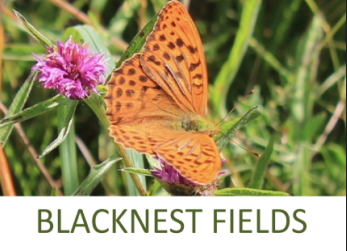Alison Melvin of Binsted Eco-Network writes about her group’s rewilding project
Thanks to ACAN for inviting your ‘country cousins’ to tell you about our Blacknest Fields project!
Situated three fields north of Blacknest’s ‘Jolly Farmer’ pub, this 8-acre site is eighteen months into its transformation as a site for nature recovery, after many decades of being used only for horse grazing. When the parish council set about evaluating how to put the land to better use, the files had scant detail about the site’s history. So began some lockdown research!
The land was awarded to the ‘Overseers of the Poor’ (parish council precursors) in 1857 for ‘the labouring poor.’ The Front Field was the parish’s original cricket pitch, until abandoned for a superior one. In World War II, the Ministry of Supply took over the site, to extract timber and manufacture charcoal for explosives. Since the war, the land had been used purely by horses.
In mid-2021, the Parish Council decided the site should be re-opened to the public, as low-key community greenspace with a focus on nature recovery. Naturally there were no wildlife records for the site – no-one except horse graziers had ever visited! But ‘the absence of evidence is not the evidence of absence.’

Adjoining Alice Holt forest has rich wildlife and woodland-edge habitats are always especially important – more birds and plants are found at woodland edges than in the hearts of woodlands. We started to sketch out how the site could best be managed, after discussions with locals and wildlife groups, and opened the site to the public in April 2022
We managed to win South Downs National Park Authority ‘Beelines’ funding for a ‘Get Blacknest Buzzing’ pollinator project. Blacknest Fields, on heavy clay, is unlike ‘traditional’ wildflower sites on chalk downland. But woodland edges are very important for pollinators, which hugely benefit when the condition of hedges and meadows is improved.

We’ve also managed to get the bridleway patched, install an owl sculpture (pictured) and bench, plant a community orchard and new hedges, and start to rejuvenate decrepit old hedges.
We needed volunteers! It was daunting to ‘magic up’ willing helpers, as we were starting from scratch. Help did materialise, but perhaps in an unexpected way.
As knowledgeable local volunteer wildlife recorders started documenting the site’s flora and fauna, they got everyone completely enthralled by the wildlife they discovered. Butterflies. Moths. Bats. Grass snakes. Lizards. Woodpeckers. Firecrests. Marsh tits.

Sharing these wildlife photos – through the Blacknest Fields’ Community FaceBook page – proved a great way to find supporters and volunteers, as people could see any efforts would have a direct benefit for wildlife. People from quite a wide area have joined volunteer work parties – including some AVLANers and Alton Naturalists. Over all, we’re continually amazed by people’s talent and generosity; a local carpenter who built us palatial owl boxes, then intrepid local tree surgeons who managed to get the owl boxes safely up into the trees.
We’ve yet to complete a full year of recording, but just between July and December last year we recorded 324 species of fauna and flora (including some ‘Red Listers’). And we’ve learned a lot about wildlife in the process. It’s true we’ve had a lot of ‘lost wellie’ incidents in Blacknest’s infamous mud – but it turns out you can also have a lot of fun, even when sliding about in mud. Whatever its imperfections, Blacknest Fields is now secure as a nature sanctuary, and it’s a lovely tranquil spot for picnics and watching wildlife. Come visit! Bring a flask. And your binoculars.
Find maps on the Facebook page described above; and find out about upcoming events by joining Blacknest Fields’ newsletter distribution (email BNF@binstedparishcouncil.org.uk)
 Alton Climate Action Network
Alton Climate Action Network